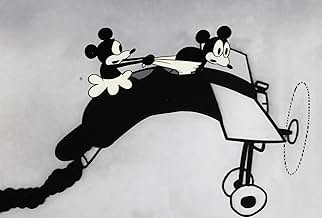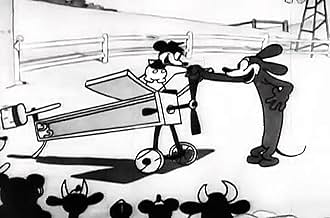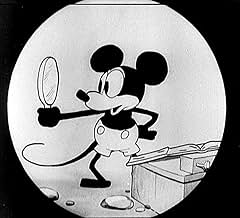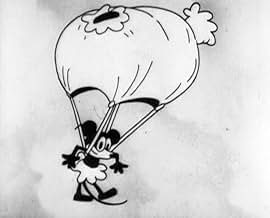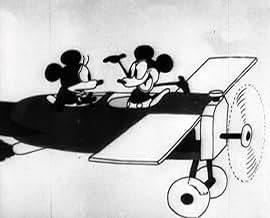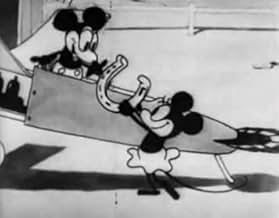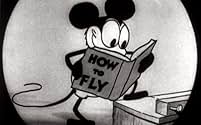AVALIAÇÃO DA IMDb
7,0/10
2,5 mil
SUA AVALIAÇÃO
Adicionar um enredo no seu idiomaInspired by Lindbergh's flight from New York to Paris, Mickey builds a plane to take Minnie for a trip involving some necking, though Minnie objects to the necking.Inspired by Lindbergh's flight from New York to Paris, Mickey builds a plane to take Minnie for a trip involving some necking, though Minnie objects to the necking.Inspired by Lindbergh's flight from New York to Paris, Mickey builds a plane to take Minnie for a trip involving some necking, though Minnie objects to the necking.
- Direção
- Artista
Walt Disney
- Mickey Mouse
- (narração)
- (não creditado)
- …
Avaliações em destaque
Although "Steamboat Willie" was the first Mickey Mouse cartoon released, this one was actually the first Mickey ever made. In fact, it was a silent film when it was first produced, but it was released after sound had been added. I remember the first time I saw this cartoon was on a video that I had rented in 1st or 2nd grade. I didn't really care much for it at the time, but now I like it. This and many other Disney animated shorts will entertain people of all ages, 3 to 103, all over the world.
Plane Crazy (1928), the first Mickey Mouse cartoon, offers modern viewers a vision of the character which has been eclipsed by a more family friendly rendition. The old school Mickey was a rascal and a jerk, always looking to cause trouble. Here we see him rough-housing other animals in a barnyard and forcing a kiss on a reluctant Minnie Mouse, something modern Mickey would blush to do.
Ub Iwerks' animation is fantastic and chaotic. Around this time, the stiffer animation of the early 1920s/late 1910s was giving way to the looser movement which would reign supreme in the 1930s.
Plane Crazy is not as mesmerizing as Steamboat Willie (1928), but it sure is a lot of fun and a great time capsule.
Ub Iwerks' animation is fantastic and chaotic. Around this time, the stiffer animation of the early 1920s/late 1910s was giving way to the looser movement which would reign supreme in the 1930s.
Plane Crazy is not as mesmerizing as Steamboat Willie (1928), but it sure is a lot of fun and a great time capsule.
This is where it all began. 'Plane Crazy (1928)' and not 'Steamboat Willie (1928),' as is often claimed marks the humble debut of Mickey Mouse, perhaps the most recognisable and beloved cartoon character ever created. This little rodent was originally envisioned as a replacement for Oswald the Lucky Rabbit, a successful character designed by Walt Disney for Charles Mintz of Universal Studios. Mintz had demanded that Disney take a pay-cut, shortly after reminding him that he personally held copyright of Oswald, and had already contracted most of Disney's employees. To Mintz's surprise, the ambitious animator and businessman instead struck out alone, animators Ub Iwerks and Les Clark among the few who remained loyal to him. The first Mickey Mouse cartoon was released on May 15, 1928, in California, where its reception was initially rather lukewarm. The animation itself is not particularly notable, but the jokes are clever, funny and amusingly mean-spirited. Mickey's following would grow, however, and more than anybody not even the forward-thinking Disney could ever have anticipated.
At least in his first year, Mickey wasn't much of a gentleman. For one, he wasn't averse to harassing livestock if he could get some benefit out of them here, a turkey is robbed of its tail feathers, and a cow is grabbed by the udder, which tastefully spurts milk everywhere. Mickey decides that he wants to be an aviator, though his knowledge stretches little beyond how Charles Lindbergh ("Lindy") styled his hair. This dangerous hobby is no doubt fuelled by a desire to impress Minnie the Mouse (here also making her debut), but, when she doesn't respond as planned, Mickey coldly forces a kiss out of her. Disney claims that inspiration for his character partially came from Charles Chaplin's tramp character, though there's very little of that here: the look of pure mischievous evil on his face after being romantically rejected by Minnie is almost frightening! 'Plane Crazy' was originally released as a silent cartoon, but, following the success of 'Steamboat Willie,' it was re-released with sound effects and synchronised music.
At least in his first year, Mickey wasn't much of a gentleman. For one, he wasn't averse to harassing livestock if he could get some benefit out of them here, a turkey is robbed of its tail feathers, and a cow is grabbed by the udder, which tastefully spurts milk everywhere. Mickey decides that he wants to be an aviator, though his knowledge stretches little beyond how Charles Lindbergh ("Lindy") styled his hair. This dangerous hobby is no doubt fuelled by a desire to impress Minnie the Mouse (here also making her debut), but, when she doesn't respond as planned, Mickey coldly forces a kiss out of her. Disney claims that inspiration for his character partially came from Charles Chaplin's tramp character, though there's very little of that here: the look of pure mischievous evil on his face after being romantically rejected by Minnie is almost frightening! 'Plane Crazy' was originally released as a silent cartoon, but, following the success of 'Steamboat Willie,' it was re-released with sound effects and synchronised music.
Plane Crazy is the very first film with Mickey and Minnie so the animated short is of some historical value. As far as the animation itself, it is just plane crazy. Mickey builds a plane and takes Minnie with him for the ride. Once they are up in the air Mickey comes on way too strong for Minnie so she ends up jumping out of the plane. In the end, Mickey got what he deserved.
It's not a great film but is a little entertaining - It's a good watch to see the beginnings of the famous couple.
7/10.
It's not a great film but is a little entertaining - It's a good watch to see the beginnings of the famous couple.
7/10.
If you go on YouTube, you're bound to find or two uploads of Plane Crazy, the very first Mickey Mouse cartoon produced by Walt Disney productions in 1928 (his way of finding a new character after losing Oswald the Rabbit at Universal). And while the short was originally done as a silent short - from a biography I read, Steamboat Willie was the third Mickey Mouse cartoon - it can now be watched with sound. On the one hand it's crazy to think that it would ever be silent considering how the music and sound effects and occasional voices for Mickey and Minnie (both from Uncle Walt) work so in sync and, really, perfectly with it all. And yet on the other hand it's easy to see how everything is told visually, without any real dialog being needed anyway (there is a moment where Minnie goes "Who, me?!" when Mickey asks her to go on the plane, but it could be left off just as well).
The gags come quick and fast, but the story is tight considering the suspense that happens once Mickey and Minnie get up in the air. Actually in a way this has more character stuff than in Steamboat Willie, which in that case was a little bit of story (the set up of Mickey as a captain and being chased by proto-Pete), but then with a lot of gags involving the playing of animals as musical instruments. Here it's all about this: what will Mickey get Minnie into next, and will he wise up and not be such a jerk? It's great to see an early Mickey short like this for a couple of reasons aside from the sharp quality of the animation - the timing of it all makes it, well, timeless far as storytelling goes, even with the old-school iris - one is that Mickey is not the perfect, bashful gentleman/mouse of later cartoons. He's actually kind of a jerk, and it's refreshing in that Bart Simpson way.
The second reason is how self-conscious the creators, Disney and Ub Iwerks, were in some of the visual gags. It may have one of my all-time favorites, one that lays kind of the blueprint for cartoons for decades to come: at one point Minnie decides she's had enough of Mickey's horsing around and gets up and leaves to parachute off the plane (luckily her dress will do). Mickey follows her off, and we see him just suspended in the air, in a straight line really, without anything showing him going down. It's only when HE realizes he's off the plane that he rushes back to get on the plane, only for it to crash. That is the magic of animated comic cartoons right there in about 15 seconds of celluloid: you don't know you're going to die until you notice it.
The gags come quick and fast, but the story is tight considering the suspense that happens once Mickey and Minnie get up in the air. Actually in a way this has more character stuff than in Steamboat Willie, which in that case was a little bit of story (the set up of Mickey as a captain and being chased by proto-Pete), but then with a lot of gags involving the playing of animals as musical instruments. Here it's all about this: what will Mickey get Minnie into next, and will he wise up and not be such a jerk? It's great to see an early Mickey short like this for a couple of reasons aside from the sharp quality of the animation - the timing of it all makes it, well, timeless far as storytelling goes, even with the old-school iris - one is that Mickey is not the perfect, bashful gentleman/mouse of later cartoons. He's actually kind of a jerk, and it's refreshing in that Bart Simpson way.
The second reason is how self-conscious the creators, Disney and Ub Iwerks, were in some of the visual gags. It may have one of my all-time favorites, one that lays kind of the blueprint for cartoons for decades to come: at one point Minnie decides she's had enough of Mickey's horsing around and gets up and leaves to parachute off the plane (luckily her dress will do). Mickey follows her off, and we see him just suspended in the air, in a straight line really, without anything showing him going down. It's only when HE realizes he's off the plane that he rushes back to get on the plane, only for it to crash. That is the magic of animated comic cartoons right there in about 15 seconds of celluloid: you don't know you're going to die until you notice it.
Você sabia?
- CuriosidadesThis was the first Mickey Mouse cartoon to be produced (as a silent short) and was shown at a Hollywood theater on May 15, 1928. It was delayed until March 17, 1929, and with an added soundtrack, was the fourth Mickey Mouse cartoon to be released.
- Erros de gravaçãoIn the beginning, Mickey is reading "How to Fly", but the title is written on the wrong cover ;it is written on the back cover of the book.
- Citações
[last lines]
Minnie Mouse: Help! Help! Help!
- Versões alternativasThis was released in a silent version months before the sound version came out.
- ConexõesEdited into The Mickey Mouse Anniversary Show (1968)
- Trilhas sonorasYankee Doodle
Traditional
Principais escolhas
Faça login para avaliar e ver a lista de recomendações personalizadas
Detalhes
Bilheteria
- Orçamento
- US$ 3.528 (estimativa)
- Tempo de duração
- 6 min
- Cor
- Mixagem de som
- Proporção
- 1.33 : 1
Contribua para esta página
Sugerir uma alteração ou adicionar conteúdo ausente

